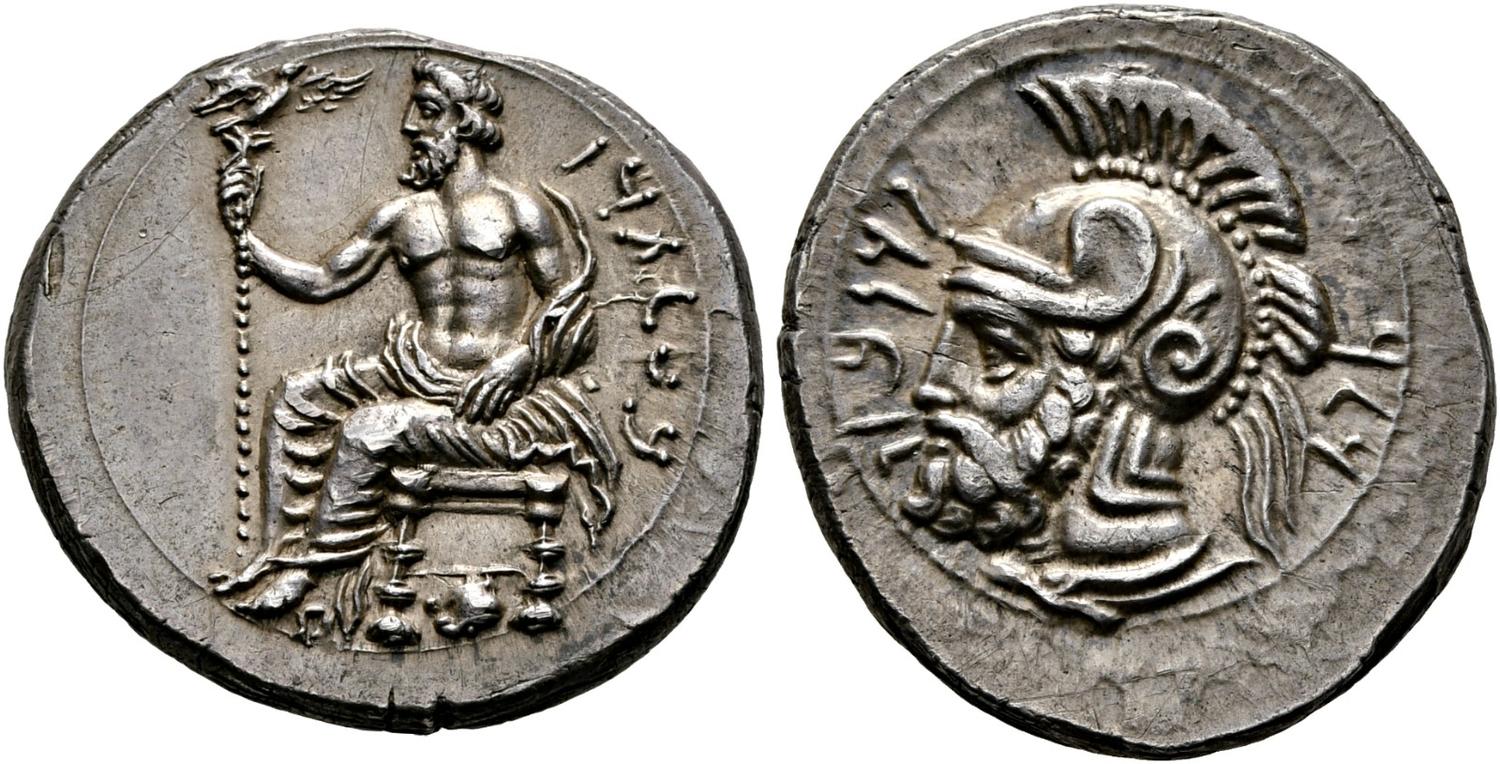Tarsus (Pharnabazus), silver, double sigloi (Baaltars/Ares) (378-373 BCE)
From SILVER
378 BCE - 373 BCE Silver 30,577 kg
Description
| ObverseInscription or printing placed on the obverse.: | BALTRZ (ie. Baal) (Aramaic).Baaltars seated on a diphros (stool) on the left, bearded, wearing a laurel wreath, draped, left arm resting on the diphros (stool), holding a scepter surmounted by a lotus flower. |
| ReverseInscription or printing placed on the reverse.: | PRNBZW (ie. Pharnabazus) (Aramaic).Bust of Ares on left, bearded, wearing a crested Attic helmet. |
Mint and issuing power
| MintIdentifies the place of manufacture or issue of a numismatic object.: | Tarsus | Ancient regionAncient region.: | Cilicia | Modern countryModern country: Turkey | AuthorityIdentifies the issuing power. The authority can be "pretended" when the name or the portrait of X is on the coin but he/she was not the issuing power. It can also be "uncertain" when there is no mention of X on the coin but he/she was the issuing power according to the historical sources: | Persian Empire, Pharnabazus II (Achaemenid Persian Satrap in Asia Minor, c. 413-374 BC) |
Chronology
| FromIdentifies the initial date in a range assigned in a numismatic context. | 378 BCE | toIdentifies the final date in a range assigned in a numismatic context.. | 373 BCE | PeriodTime period of the numismatic object.: Classical 480-323 BC |
Physical description
| MetalThe physical material (usually metal) from which an object is made.: | Silver |
Median weightMedian of the weights of numismatic objects (in grams). in grams | 10.60 | DenominationTerm indicating the value of a numismatic object. Examples: tetradrachm, chalkous, denarius.: | double siglos |
StandardStandard.: | Persian |
Image

AC274 Tarsus.jpeg [1]
References
| Die study referencePublication of the study: | Moysey 19861Moysey 1986 | ||
| Coin series referenceReference to coin series study: | RQEMAC2RQEMAC, n° 274 | ||
| Coin series web referenceCoin series web references: | |||
Obverse dies distribution
| FrequencyFrequency of specimen in distribution. ᵖ | Number of obversesNumber of obverse dies. ᵖ (o) | % (o) | Number of coinsNumber of coins. (n) | % (n) | Die nameName(s) of the die(s). |
| 1 | 43 | 71.67 | 43 | 47.78 | 1, 2, 3, 4, 5, 6, 7, 8, 9, 11, 12, 13, 14, 15, 17, 18, 21, 22, 23, 24, 25, 26, 27, 31, 32, 33, 34, 37, 38, 40, 41, 43, 44, 45, 48, 49, 50, 51, 52, 53, 57, 58, 60 |
| 2 | 12 | 20 | 24 | 26.67 | 10, 16, 20, 29, 30, 35, 39, 42, 47, 54, 55, 56 |
| 3 | 1 | 1.67 | 3 | 3.33 | 36 |
| 4 | 1 | 1.67 | 4 | 4.44 | 59 |
| 5 | 2 | 3.33 | 10 | 11.11 | 19, 46 |
| 6 | 1 | 1.67 | 6 | 6.67 | 28 |
| Total | 60 of 60 | 100.01 | 90 of 90 | 100 |
Reverse dies distribution
no distribution is available
Quantification
| Number of obversesNumber of obverse dies. ᵖ (o) | 60 | Number of singletons (o1)The number of singleton coins. ᵖ | 43 |
| Number of reverse diesNumber of reverse dies. (r) | 74 | Number of coinsNumber of coins. (n) | 90 |
| Coins per obverse dieNumber of coins per obverse die. (n/o) | 1.5 | Coins per reverse dieNumber of coins per reverse die. (n/r) | 1.22 |
| Reverse per obverse ratioRatio of obverse dies divided by reverse dies. (r/o) | 1.23 | Percentage of singletons (o1)number of coins (n) divided by the number of singletons (o1) ᵖ | 71.67 % |
| Original number of dies (O) (Carter 1983 formula)The estimation of the number of coins according to Carter 1983 ᵖ | 144.23 | Coins struck if 20,000 as average productivity per dieCoins made if the average productivity for obverses (according to Carter) is 20,000. ᵖ | 2,884,600 |
| Original number of dies (O) (Esty 2011 formula)The estimation of the number of coins according to the singleton formula in Esty 2011 ᵖ (O) | 180 | Survival rate if 20,000 as average productivity per dieSurvival rate if average productivity is 20,000. ᵖ | 0.00003 |
| Coverage (o = % of O) (Esty 1984 formula)Esty 1984 - coverage (% of O) ᵖ (o = % of O) | 52.22% | Die productivity if survival rate 1/2,000Average productivity if survival rate is 1/2,000. ᵖ | 1,248.01 |
| Weight of silver (in kg) if 20,000 coins per die (O = Carter formula)Carter 1983 * Median weight * 20000 (*10 if gold or electrum) ᵖ | 30,577 kg <br /> 30,577 kg | Die productivity if survival rate 1/5,000Average productivity if survival rate is 1/5,000. ᵖ | 3,120.02 |
Remarks
Certainly military
References
- ^ Moysey, Robert A. (1986), "The Silver Issues of Pharnabazos and Datames from the Mint of Tarsus in Cilicia", American Numismatic Society Museum Notes, 31, p. 7-61, pl. 1-5.
- ^ Callataÿ, François de (2003), Recueil quantitatif des émissions monétaires archaïques et classiques, Numismatique Romaine, Wetteren, VII + 267 p.